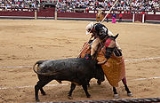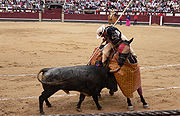
Picador
Encyclopedia

A picador is one of the pair of horse
Horse
The horse is one of two extant subspecies of Equus ferus, or the wild horse. It is a single-hooved mammal belonging to the taxonomic family Equidae. The horse has evolved over the past 45 to 55 million years from a small multi-toed creature into the large, single-toed animal of today...
men in a Spanish
Spain
Spain , officially the Kingdom of Spain languages]] under the European Charter for Regional or Minority Languages. In each of these, Spain's official name is as follows:;;;;;;), is a country and member state of the European Union located in southwestern Europe on the Iberian Peninsula...
bullfight that jab the bull with a lance
Lance
A Lance is a pole weapon or spear designed to be used by a mounted warrior. The lance is longer, stout and heavier than an infantry spear, and unsuited for throwing, or for rapid thrusting. Lances did not have tips designed to intentionally break off or bend, unlike many throwing weapons of the...
. They perform in the tercio de varas which is the first of the three stages in a Spanish bullfight.
The picador has three main functions:
- To pierce the muscle on the back of the bull’s neck in order to straighten the bull's charge.
- To fatigue the bull’s neck muscles and general stamina as it tries to lift the horse with its head.
- To lower the bull’s head in preparation for the next stage.
If the public feels that a picador is over-enthusiastic in his lancing they will whistle, boo or jeer as they see fit. This is because they do not want the bull to lose all its strength and energy as this can lead to a dull bullfight.
The picador is obliged to give the bull two lances in a first category bull ring (Barcelona
Barcelona
Barcelona is the second largest city in Spain after Madrid, and the capital of Catalonia, with a population of 1,621,537 within its administrative limits on a land area of...
, Madrid
Madrid
Madrid is the capital and largest city of Spain. The population of the city is roughly 3.3 million and the entire population of the Madrid metropolitan area is calculated to be 6.271 million. It is the third largest city in the European Union, after London and Berlin, and its metropolitan...
, Sevilla, Zaragoza
Zaragoza
Zaragoza , also called Saragossa in English, is the capital city of the Zaragoza Province and of the autonomous community of Aragon, Spain...
etc.) but the matador
Matador
A torero or toureiro is a bullfighter and the main performer in bullfighting, practised in Spain, Colombia, Portugal, Mexico, France and various other countries influenced by Spanish culture. In Spanish, the word torero describes any of the performers who actively participate in the bullfight...
may request that the second is waived in second and third category rings. The bull may receive three lances if it is particularly ferocious.
The willingness of the bull to charge the picador is often cited as the biggest test of its courage. A bull that does not charge may be punished with a black banderilla
Banderilla
Banderilla is a diminutive meaning small flag in the Spanish language and may refer to :*Banderilla in the English language most often refers to the colorfully decorated and barbed sticks used in bullfighting, as illustrated on this page....
, which although somewhat longer than a normal banderilla is largely symbolic and a mark of shame for the breeder. This is very rare.
Prior to 1928, horses did not wear protection and the bull would on occasion disembowel the horse during this stage. In Seville they retain two teams of muleteros, one to drag out the dead bull and the other to drag out any dead horses (this is now just for tradition). These days the horse is surrounded by a peto, a mattress-like protection that greatly minimizes damage taken. However, injuries to the horses often include broken ribs and damage to internal organs.
In the original days before bullfighting became recognisable in today's form, the picador was the central attraction and his name would be billed on the promotional flyers. In these bullfights the bull would charge the horse and the spectacle was watching the rider's skill in protecting his horse whilst lancing the bull. The picador would lance the bull as many times as necessary. The matador and other bullfighters were on hand to help the picador, to direct the bull to the picador, and finally to finish off the injured bull. It was not until certain foot bullfighters started to bring some flair to their minor roles, to the pleasure of the crowd, that matadors started to become the main attraction, ultimately relegating the picador to a relatively unpopular and minor function.
External links
- ToroPedia.com The English Language Online Encyclopedia of Bullfighting

